fuel cap AUDI S6 2015 User Guide
[x] Cancel search | Manufacturer: AUDI, Model Year: 2015, Model line: S6, Model: AUDI S6 2015Pages: 314, PDF Size: 77.57 MB
Page 222 of 314
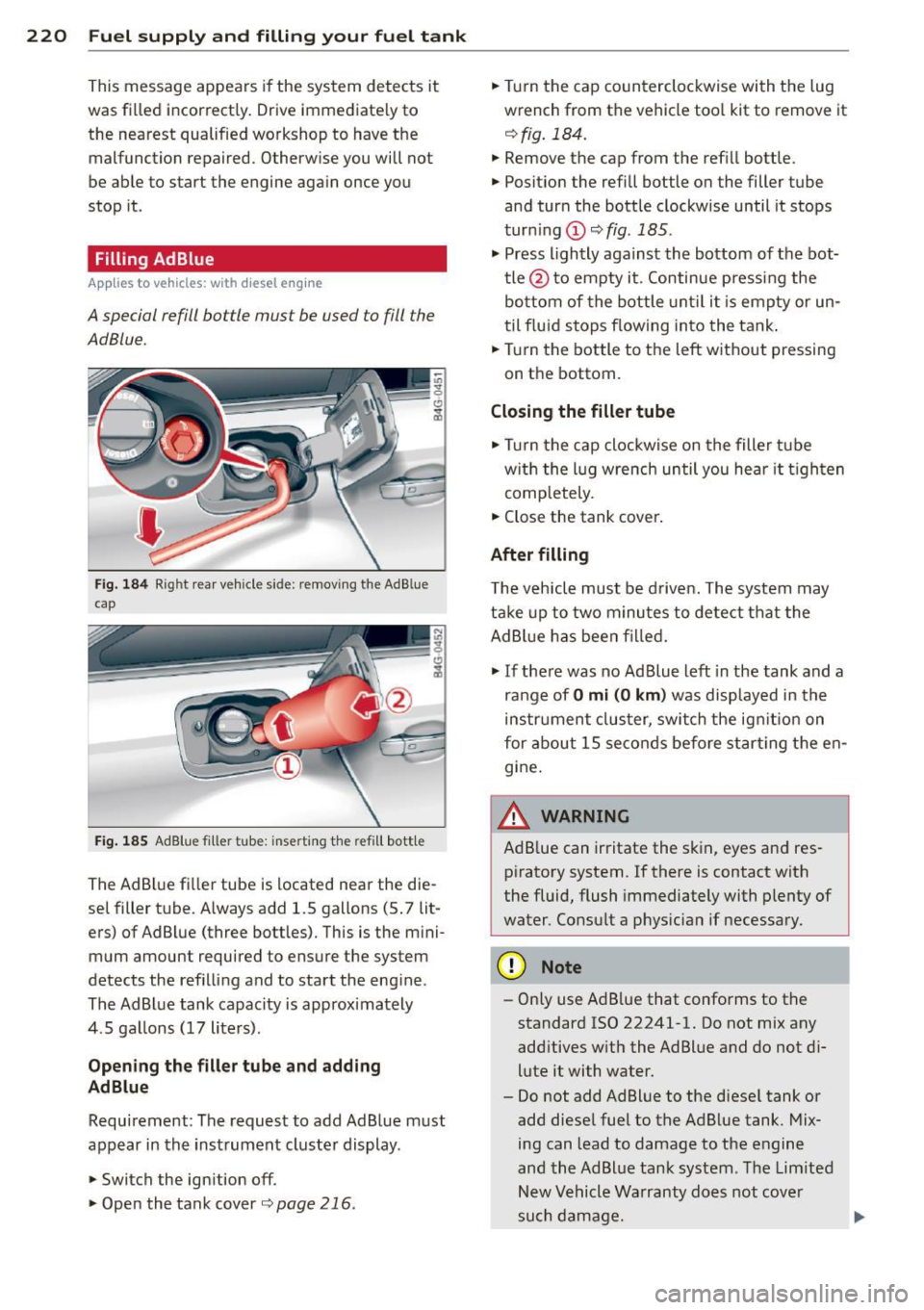
220 Fuel supply and filling your fuel tank
This message appears if the system detects it
was filled incorrect ly. Drive immediate ly to
the nearest qualified workshop to have the malfunction repaired. Otherwise you will not
be able to start the engine again once you
stop it.
Filling AdBlue
App lies to vehicles: with diesel eng in e
A special refill bo ttle must be used to fill the
AdBlue.
Fig. 184 Rig ht rear vehicle si de: removing the Ad Blue
cap
Fig. 185 Ad8lue filler tub e: inse rting the refi ll bott le
The Ad Blue fi ller tube is located near the die
sel filler tube. Always add 1.5 gallons (5 . 7 lit
ers) of AdBlue (three bottles). This is the mini
mum amount required to ensure the system
detects the refilling and to start the engine.
The Ad Blue tank capacity is approximately
4 .5 gal lons (17 liters).
Opening the filler tube and adding
AdBlue
Requirement: The request to add Ad Blue must
appear in the instrument cluster display.
• Switch the ignition off.
• Open the tank cover
c:;,poge 216.
• Turn the cap counterclockwise with the lug
wrench from the vehicle too l kit to remove it
C::,fig. 184.
• Remove the cap from the refill bottle.
• Position the refill bottle on the filler tube
and turn the bottle clockwise until it stops
turning
(D ~ fig. 185 .
• Press lightly against the bottom of the bot
tle @to empty it . Continue pressing the
bottom of the bottle until it is empty or un
til fluid stops flowing into the tank.
• Turn the bottle to the left without pressing
on the bottom.
Closing the filler tube
• Turn the cap clockwise on the filler tube
w ith the lug wrench until you hear it tighten
completely .
• Close the tank cover .
After filling
The vehicle must be driven. The system may
take up to two minutes to detect that the
AdBlue has been filled.
• If there was no Ad Blue left in the tank and a
range of
O mi (0 km ) was displayed in the
ins trument cluster, switch the ign ition on
for about 15 seconds before start ing the en
gine.
_& WARNING
-Ad Blue can irritate the skin, eyes and res
piratory system. If there is contact with
the fluid, flush immediately with plenty of
water. Consult a phys ician if necessary.
(D Note
-Only use Ad Blu e that conforms to the
standard ISO 22241-1. Do not mix any
additives with the AdBlue and do not di
lute it with water.
- Do not add Ad Blue to the diese l tank or
add diese l fuel to the Ad Blue tank. Mix
ing can lead to damage to the engine
and the AdBlue tank system . The Limited
New Vehicle Warranty does not cover
such damage.
Page 223 of 314
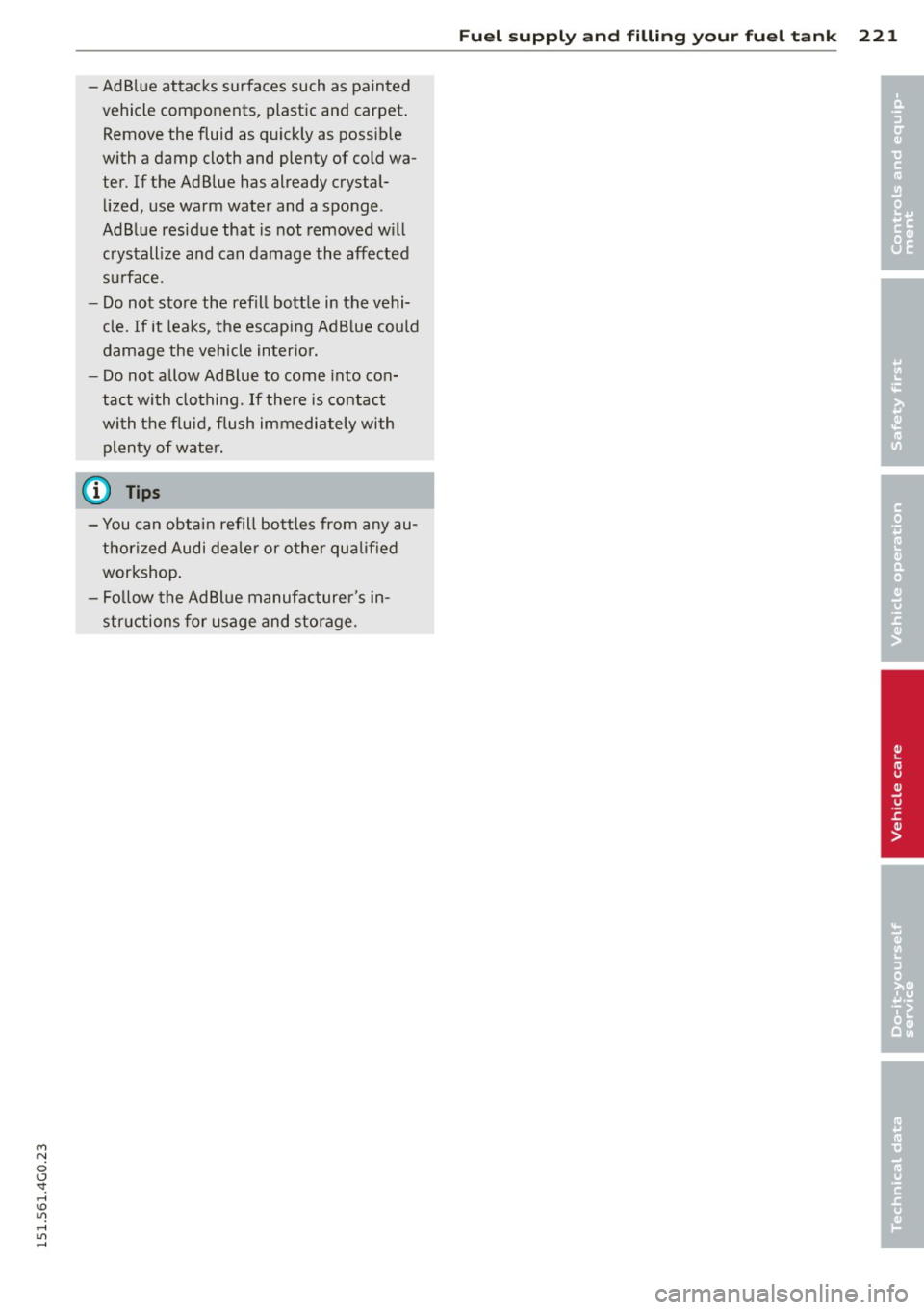
M N
0 <.J 'SI: ,...., \!) ..,.,
,...., ..,., ,....,
-Ad B lue attacks surfaces such as painted
vehicle components, plastic and carpet .
Remove the fluid as quick ly as possib le
with a damp cloth and plenty of cold wa
ter. If the Ad Blue has already crystal
lized, use warm water and a sponge.
AdB lue residue that is not removed w ill
crystall ize and can damage the affected
su rface.
- Do not store the refill bott le in the vehi
cle. If it leaks, the escap ing Ad B lue could
damage the vehicle inter ior.
- Do not allow AdBlue to come into con
tact with clo thing. If there is contact
wi th the f lui d, flush immedi ately with
plenty of w ater .
(D Tips
-You can obtain refill bott les from any au
thorized Audi de aler or o ther qua lified
workshop .
- Follow the AdBl ue manufacturer's in
str uctions for usage and storage.
Fuel supply and filling your fuel tank 221
•
•
Page 224 of 314
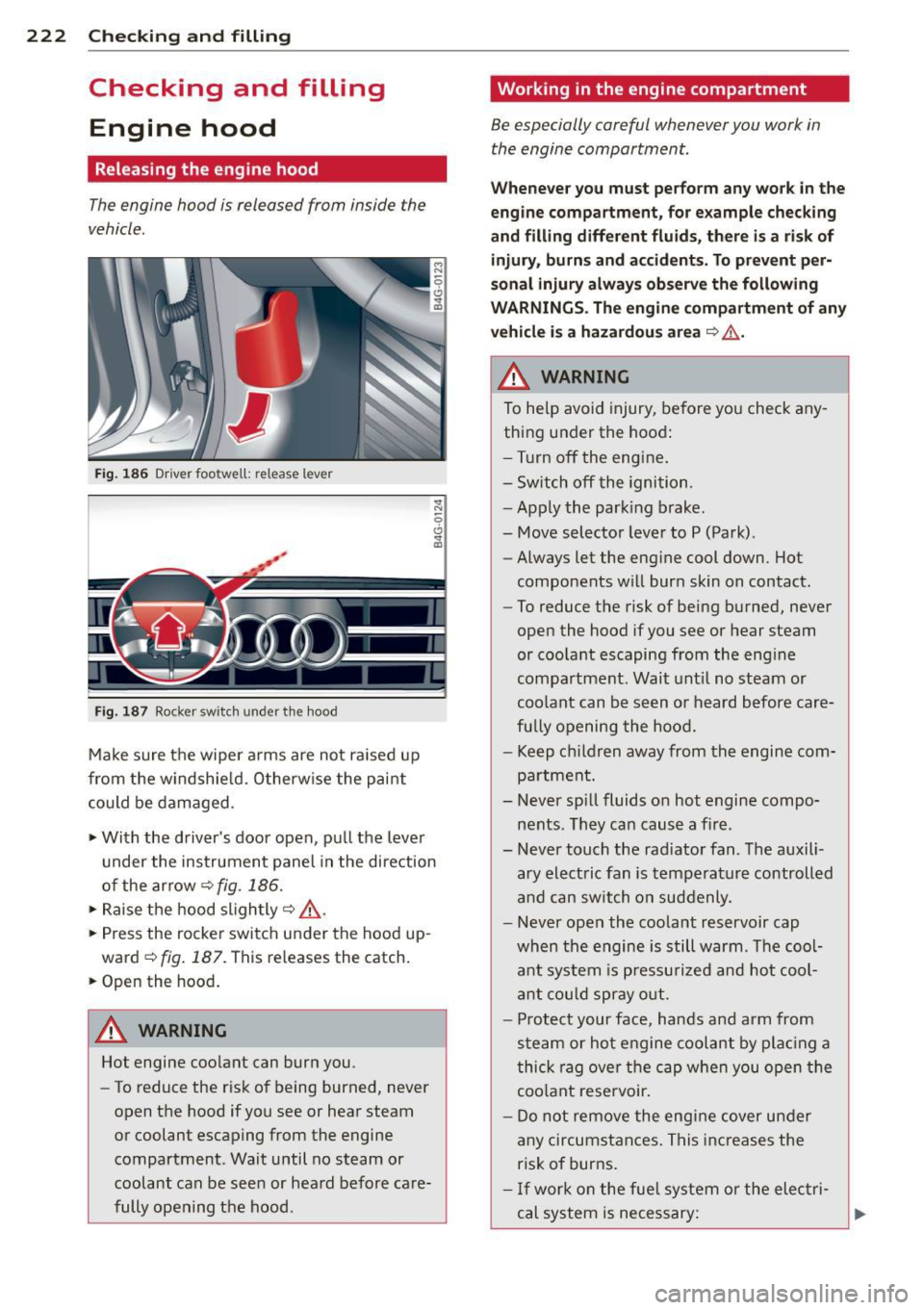
222 Checking and filling
Checking and filling Engine hood
Releasing the engine hood
The engine hood is released from inside the
vehicle .
Fig. 186 Driver foo twell: release lever
Fig. 187 Rocker switch un der the hood
Make sure the wiper arms are not raised up
from the windshield. Otherwise the paint
could be damaged .
.,. With the driver's door open, pull the lever
under the instrument panel in the direction
of the arrow ¢
fig. 186.
... Raise the hood slightly¢.&_ .
... Pr ess the rocker switch under the hood up
ward ~
fig. 187. This releases the catch.
.,. Open the hood.
A WARNING
Hot engine coolant can burn you.
- To reduce the risk of being burned, never
open the hood if you see or hear steam
or coolant escaping from the engine
compartment . Wait until no steam or
coolant can be seen or heard before care
fully opening the hood .
' Working in the engine compartment
Be especially careful whenever you work in
the engine compartment.
Whenever you must perform any work in the
engine compartment, for example checking
and filling different fluids, there is a risk of injury, burns and accidents. To prevent per
sonal injury always observe the following
WARNINGS. The engine compartment of any
vehicle is a hazardous area
¢ ,&. .
A WARNING
To help avoid injury, before you check any
thing under the hood:
- Turn off the engine.
- Switch off the ignition .
- Apply the parking brake.
- Move selector lever to P (Park).
- Always let the engine cool down. Hot
components will burn skin on contact.
- To reduce the risk of being burned, never
open the hood if you see or hear steam
or coolant escaping from the engine
compartment. Wait until no steam or
coolant can be seen or heard before care
fully opening the hood.
- Keep children away from the engine com
partment.
- Never spill fluids on hot engine compo
nents . They can cause a fire .
- Never touch the radiator fan. The auxili
ary electric fan is temperature controlled
and can switch on suddenly .
- Never open the coolant reservoir cap
when the engine is still warm . The cool
ant system is pressurized and hot cool
ant could spray out.
- Protect your face, hands and arm from
steam or hot engine coolant by placing a
thick rag over the cap when you open the
coolant reservoir.
- Do not remove the engine cover under
any circumstances. This increases the
risk of burns.
- If work on the fuel system or the electri-
cal system is necessary: ..,_
Page 228 of 314

226 Checking and filling
@ Tips
-The oil pres sure warning display. is
not an indicator of the oil level. Do not
rely on it. Instead , check the oil level in
your engine at regular intervals, pref
erably each t ime you refuel, and always
before going on a long trip.
- If you have the impression your engine
consumes excessive amounts of oil, we
r ecommend that you consult your Audi
dealer to have the cause of your concern
properly diagnosed. Keep in mind that
the accurate measurement of oil con
sumption requires great care and may
take some time. Your Audi dealer has in
str uctions about how to measure oil con
sumption accurately.
Checking the engine oil level
Fig. 189 Display: o il level indicato r
"'"Park your vehicle on a level surface .
"'"Shu t the engine off when it is warm.
"'" Switch only the ignition back on.
"'"W ait approximately two min utes .
"'" Se lect:
I CAR I function button > (Car)* sys-
tems
con trol button > Servicing & checks >
Oil level.
"'"Check the oil level in the display¢ fig. 189 .
Add engine oil if the bar of the oil level indi
cator is near "min" ~
page 226 .
Depending on the way the veh icle is driven
and the operating conditions, oil consumption
can be up to 1/2 quart per 600 m iles (0.5 liter
per 1,000 km) . Consumption may be higher
within the f irst 3,000 miles (5,000 km).
(D Tips
The oil leve l indicator in t he MMI Display is
on ly an information display. If the oil level
i s low, a min imum oil warn ing appears in
the instrument cluster. Add oil
¢
page 226. If the hood has been opened,
the current oil level is shown in the instru
ment cluster the next t ime the ignition is
switched on.
Adding engine oil~
Fig . 190 Engine compa rtment: cover on the e ngin e oi l
filler neck
Before you check anything in the engine com
partm ent,
always read and heed all WARN
INGS
¢ A in Working in the engine compart
ment on page 222.
"'" Shut the eng ine off.
"'"U nscrew the cap
'1:::::11 to the engine oi l filling
hole ¢
fig. 190, ¢ page 224, fig. 188 .
"'"Carefully top off with 0 .5 quarts (0 .5 liters)
of the appropriate oil¢
page 224.
"'" Check the oil level again after two minutes
¢ page 226, Checking the engine oil level.
"'"Top off the o il aga in, if necessary .
"'" Screw the cap back on the fi lling hole .
_&. WARNING
-While topping off, the oil must not come
in contact with hot e ngine parts -fire
hazard!
- The oil filler cap must be properly se
cured to prevent oil from being sprayed
on the hot engine and exhaust system
when the engine is running -fire hazard! ..,_
Page 242 of 314
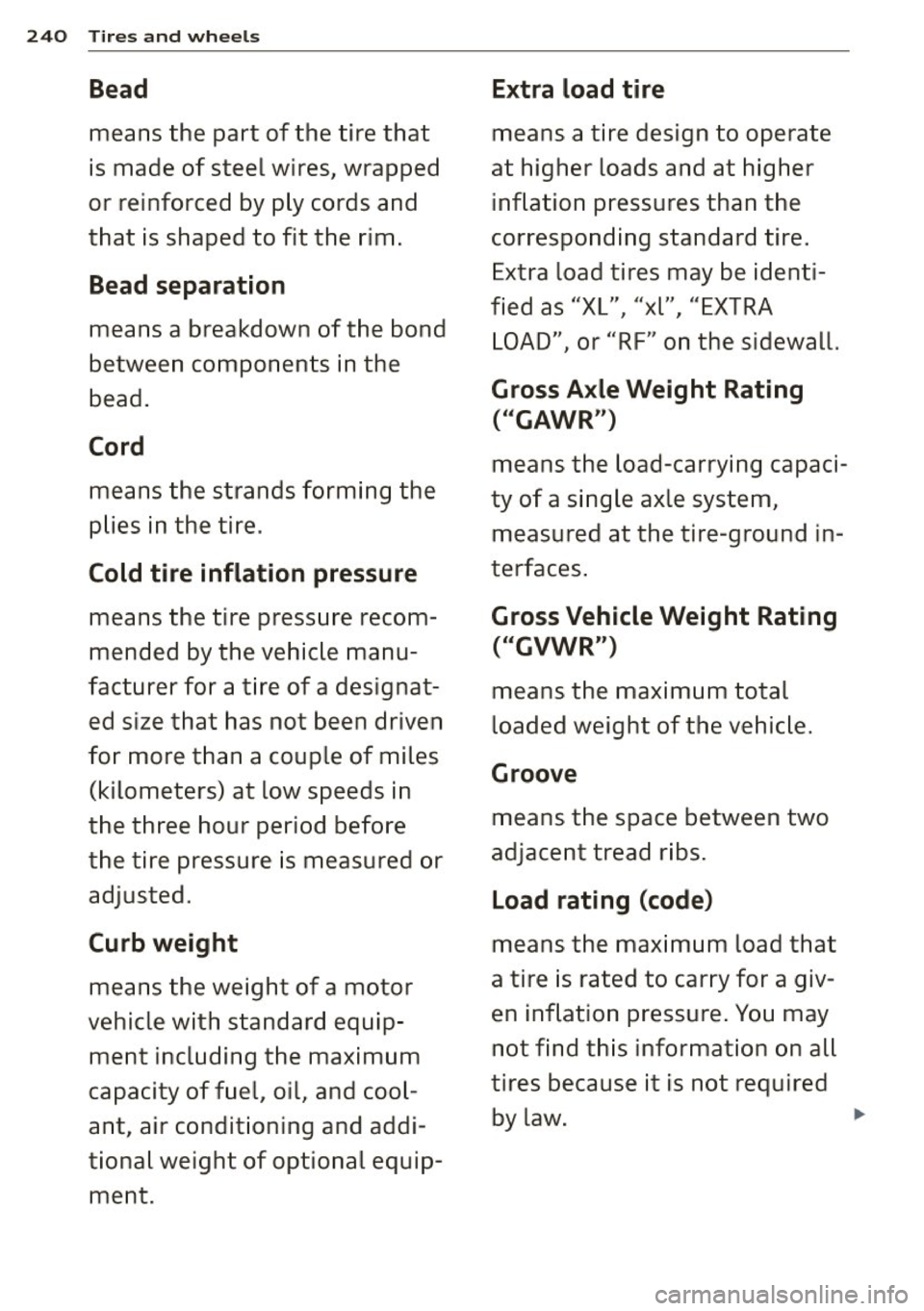
240 Tires and whee ls
Be ad Extra load t ire
means the part of the tire that means a tire design to operate
is made of steel wires, wrapped at higher loads and at higher
or reinforced by ply cords and inflation pressures than the
that is shaped to fit the rim . corresponding standard tire.
Bead separation Extra load tires may be identi-
fied as "XL", "xl", "EXTRA
means a breakdown of the bond LOAD", or "RF" on the sidewall.
between components in the
bead .
Gross A xle Weight Rating
(" GAWR ")
Cord
means the load-carrying capaci-
means the strands forming the ty of a single axle system,
p lies in the tire .
measured at the tire-ground in-
Cold tire inflation pressure terfaces.
means the tire pressure recom-
Gross Vehicle Weight Rating
mended by the vehicle manu-( "GVWR ")
facturer for a t ire of a designat-
means the maximum total
ed size that has not been driven loaded weight of the vehicle.
for more than a couple of miles
Groove
(kilometers) at low speeds in
the three hour period before means the space between two
the tire pressure is measured or adjacent tread
ribs.
adjusted.
Load rating (code)
Curb weight
means the max imum load that
means the weight of a motor a tire
is rated to carry for a giv-
vehicle with standard equip -en inflation pressure
. You may
ment including the maximum not find
this information on all
capacity of fuel, oil , and cool- tires because it is not required
ant, air conditioning and addi- by law.
...
tiona
l weight of optional equip-
ment.
Page 254 of 314
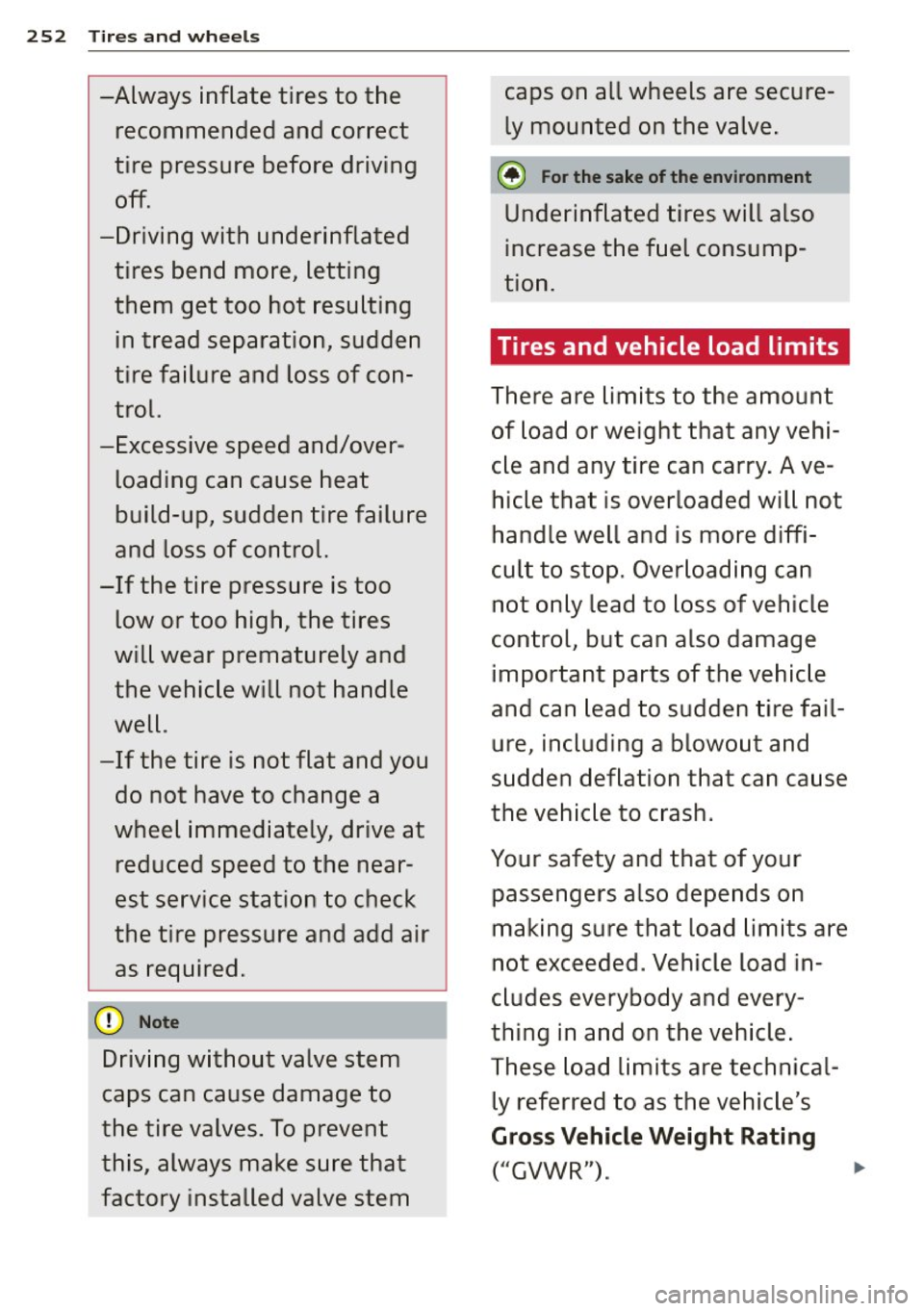
252 Tires and wheels
-Always inflate tires to the
recommended and correct
tire pressure before driving
off .
-Driving with underinflated tires bend more, letting
them get too hot resulting
in tread separation, sudden
tire failure and loss of con
trol.
-Excessive speed and/over loading can cause heat
build-up, sudden tire failure
and loss of control.
-If the tire pressure is too low or too high, the tires
will wear prematurely and the vehicle will not handle
well.
- If the tire is not flat and you
do not have to change a
wheel immediately, drive at
reduced speed to the near
est service station to check
the tire pressure and add air
as required.
@ Note
Driving without valve stem
caps can cause damage to
the tire valves. To prevent
this, always make sure that
factory installed valve stem caps on all
wheels are secure
ly mounted on the valve.
@) For the sake of the environment
Underinflated tires will also
increase the fuel consump
tion.
Tires and vehicle load limits
There are limits to the amount of load or weight that any vehi
cle and any tire can carry. Ave
hicle that is overloaded will not
handle well and is more diffi
cult to stop. Overloading can not only lead to loss of vehicle
control, but can also damage
important parts of the vehicle
and can lead to sudden tire fail
ure, including a blowout and
sudden deflation that can cause
the vehicle to crash.
Your safety and that of your
passengers also depends on
making sure that load limits are
not exceeded. Vehicle load in
cludes everybody and every
thing in and on the vehicle.
These load limits are technical
ly referred to as the vehicle's
Gross Vehicle Weight Rating
("GVWR "). .,..
Page 255 of 314
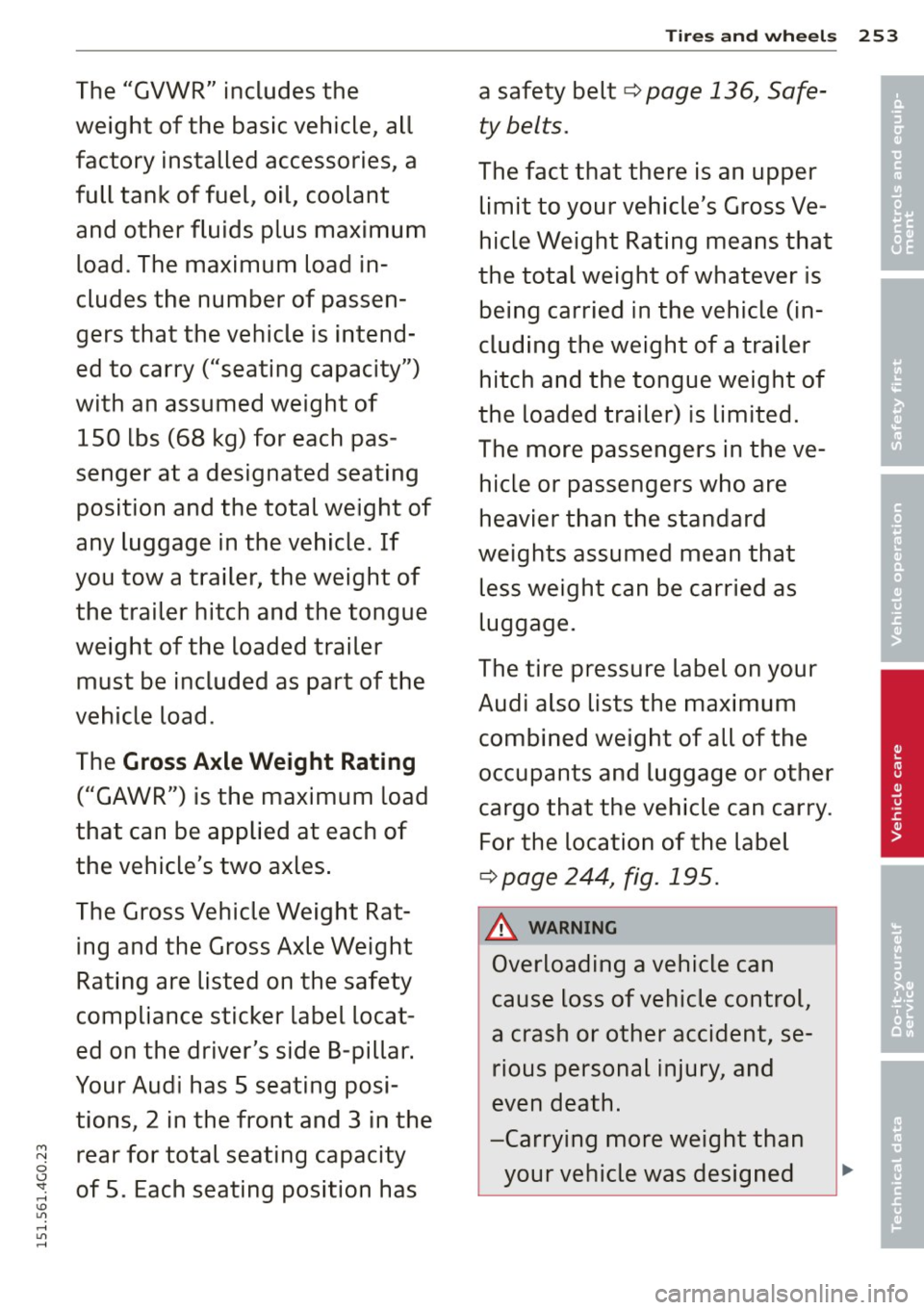
M N
0 <.J 'SI: ,...., \!) 1.1'1 ,...., 1.1'1 ,....,
The "GVWR" includes the
weight of the basic vehicle, all
factory installed accessories, a
full tank of fuel, oil, coolant and other fluids plus maximum
load. The maximum load in
cludes the number of passen
gers that the vehicle is intend
ed to carry ("seating capacity")
with an assumed weight of 150 lbs (68 kg) for each pas
senger at a designated seating
position and the total weight of
any luggage in the vehicle. If
you tow a trailer, the weight of the trailer hitch and the tongue
weight of the loaded trailer
must be included as part of the
vehicle load.
The
Gross Axle Weight Rating
("GAWR") is the maximum load
that can be applied at each of
the vehicle's two axles.
The Gross Vehicle Weight Rat ing and the Gross Axle Weight Rating are listed on the safety
compliance sticker label locat
ed on the driver's side B-pillar.
Your Audi has 5 seating posi
tions, 2 in the front and 3 in the rear for total seating capacity
of 5. Each seating position has
Tires and wheels 253
a safety belt¢ page 136, Safe
ty belts.
The fact that there is an upper
limit to your vehicle's Gross Ve
hicle Weight Rating means that
the total weight of whatever is being carried in the vehicle (in
cluding the weight of a trailer
hitch and the tongue weight of
the loaded trailer) is limited.
The more passengers in the ve
hicle or passengers who are
heavier than the standard
weights assumed mean that less weight can be carried as
luggage.
The tire pressure label on your
Audi also lists the maximum combined weight of all of the
occupants and luggage or other
cargo that the vehicle can carry.
For the location of the label
¢ page 244, fig. 195.
A WARNING
-
Overloading a vehicle can
cause loss of vehicle control,
a crash or other accident, se
rious personal injury, and
even death.
-Carrying more weight than your vehicle was designed
•
•
'
'
• •
Page 267 of 314
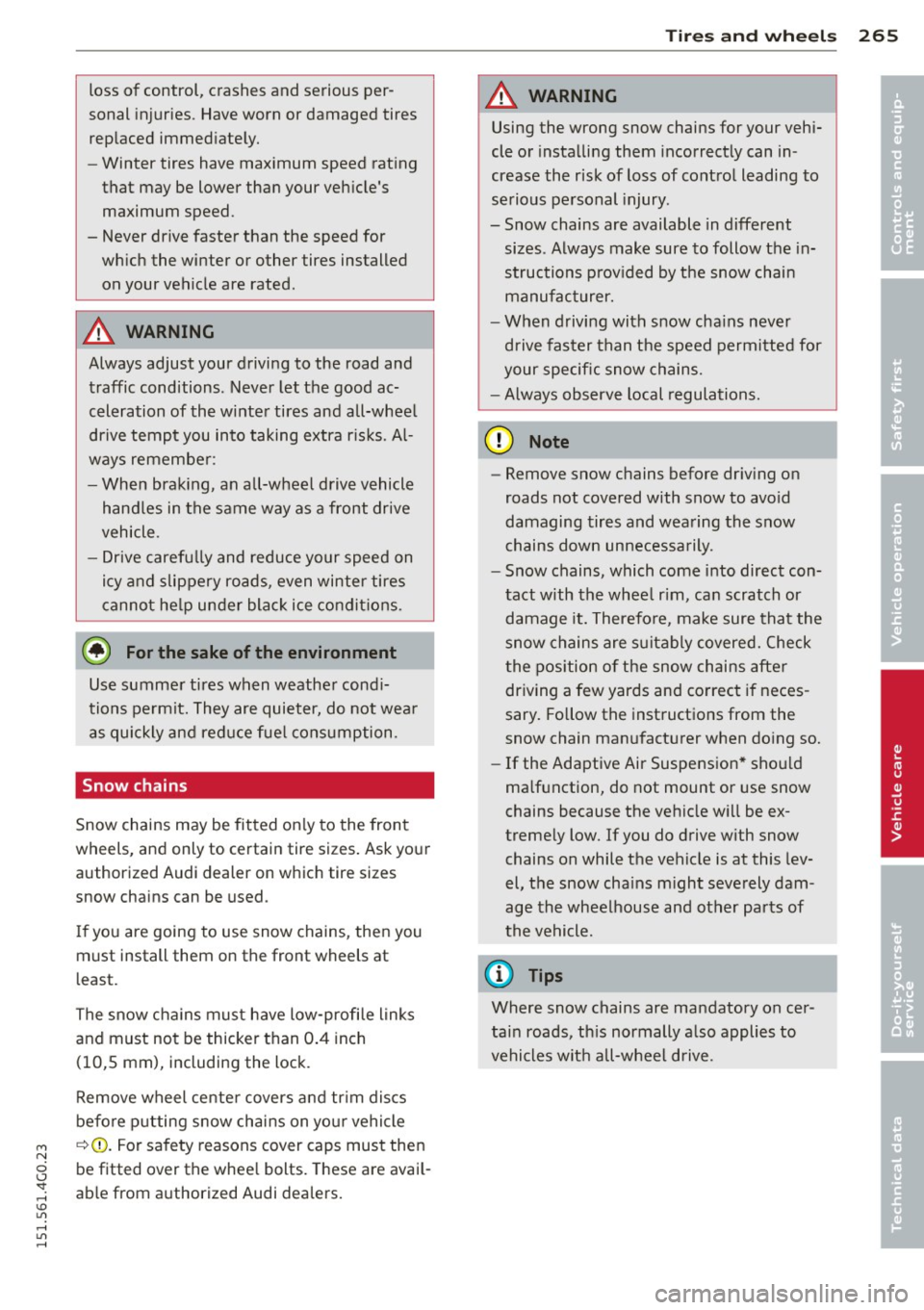
M N
0 <.J 'SI: ,...., \!) ..,.,
,...., ..,., ,....,
loss of control, crashes and serious per
sonal injuries . Have worn or damaged tires
replaced immediate ly.
- Winter tires have maximum speed rating
that may be lower than your vehicle's
maximum speed.
- Never drive faster than the speed for
which the winter or other tires installed
on your vehicle are rated.
A WARNING
Always adjust your driving to the road and
traffic conditions. Never let the good ac
celeration of the winter tires and all-wheel
drive tempt you into taking extra risks. Al
ways remember:
- When braking, an all-wheel drive vehicle
handles in the same way as a front drive
vehicle.
- Drive carefully and reduce your speed on
icy and slippery roads, even winter tires
cannot help under black ice conditions.
@) For the sake of the environment
Use summer tires when weather condi
tions permit. They are quieter, do not wear
as quickly and reduce fuel consumption.
Snow chains
Snow chains may be fitted only to the front
wheels, and only to certain tire sizes. Ask your
authorized Audi dealer on which tire sizes
snow chains can be used.
If you are going to use snow chains, then you
must install them on the front wheels at
least.
The snow chains must have low-profile links
and must not be thicker than 0.4 inch (10,5 mm), including the lock.
Remove wheel center covers and trim discs
before putting snow chains on your vehicle
q(D _ For safety reasons cover caps must then
be fitted over the wheel bolts. These are avail
able from authorized Audi dealers.
Tires and wheels 265
A WARNING
Using the wrong snow chains for your vehi
cle or installing them incorrectly can in
crease the risk of loss of control leading to
serious personal injury.
- Snow chains are available in different sizes . Always make sure to follow the in
structions provided by the snow chain
manufacturer.
- When driving with snow chains never
drive faster than the speed permitted for
your specific snow chains.
- Always observe local regulations.
([) Note
-Remove snow chains before driving on
roads not covered with snow to avoid
damaging tires and wearing the snow
chains down unnecessarily.
- Snow chains, which come into direct con
tact with the wheel rim, can scratch or
damage it. Therefore, make sure that the
snow chains are suitably covered. Check
the position of the snow chains after
driving a few yards and correct if neces
sary. Follow the instructions from the
snow chain manufacturer when doing so.
- If the Adaptive Air Suspension* should
malfunction, do not mount or use snow
chains because the vehicle will be ex
tremely low. If you do drive with snow
chains on while the vehicle is at this lev
el, the snow chains might severely dam
age the wheelhouse and other parts of
the vehicle.
(D Tips
Where snow chains are mandatory oncer
tain roads, this normally also applies to
vehicles with all-wheel drive.
•
•
Page 292 of 314
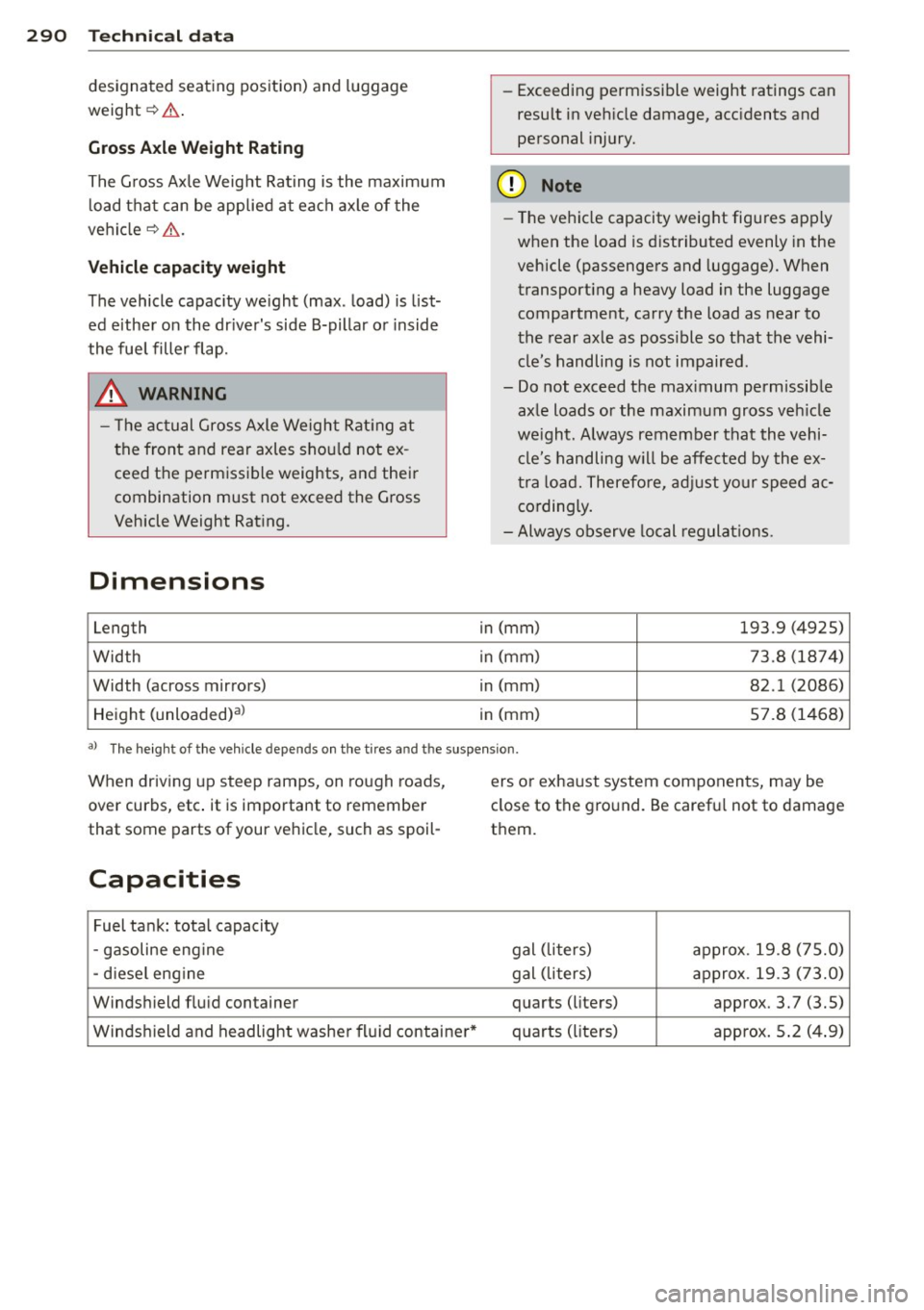
29 0 Techni cal data
designated seating position) and luggage
weight¢ .&,.
Gross Axle W eight Rating
The Gross Axle Weight Rating is the maximum
l oad that can be applied at each axle of the
vehicle ¢Lr!, .
Vehicle cap acit y weight
The vehicle capac ity we ight (max. load) is list
ed either on the dr iver's side B-pilla r or inside
the fuel filler flap.
_& WARNING
- T he actual Gross Axle Weight Rat ing at
the front and rear axles shou ld not ex
ceed the permissible weights, and their
combination must not exceed the Gross
Vehicle Weight Rating.
Dimensions
Length
Width
Width (across mirrors) Height (unloaded)al
-
-Exceeding permissible weight ratings can
result in vehicle damage, accidents and
personal injury.
(D Note
- The vehicle capacity weight figures apply
when the load is distributed evenly in the
vehicle (passengers and luggage). When
transport ing a heavy load in the luggage
compartment, carry the load as near to
the rear axle as poss ible so that the vehi
cle's handling is not impaired.
- Do not exceed the maximum permissible axle loads or the maximum gross veh icle
we ight. Always remember that the vehi
cle's handling w il l be affected by the ex
tra load. Therefo re, adj ust your speed ac
cordingly.
- Always observe local regulat ions.
in (mm)
193.9 (4925)
i n (mm) 73.8 (1874)
in (mm)
82.1 (2086)
in (mm) 57.8 (1468)
al The he ight of the veh icle depen ds on the t ires and the suspension.
When driving up steep ramps, on rough roads,
over curbs, etc . it is important to remember
that some parts of your vehicle, such as spoil-
Capacities
Fuel tank: total capacity
-gasoline engine
- d iesel engine
Windsh ield fluid container
Windsh ield and headlight washer fluid containeir* ers
or exhaust system components, may be
close to the ground . Be carefu l not to damage
them.
gal ( liters)
approx. 19.8 (75.0)
gal ( liters) approx. 19.3 (73.0)
quarts (liters) approx. 3.7 (3.5)
quarts (liters) approx. 5.2 (4 .9)
Page 304 of 314
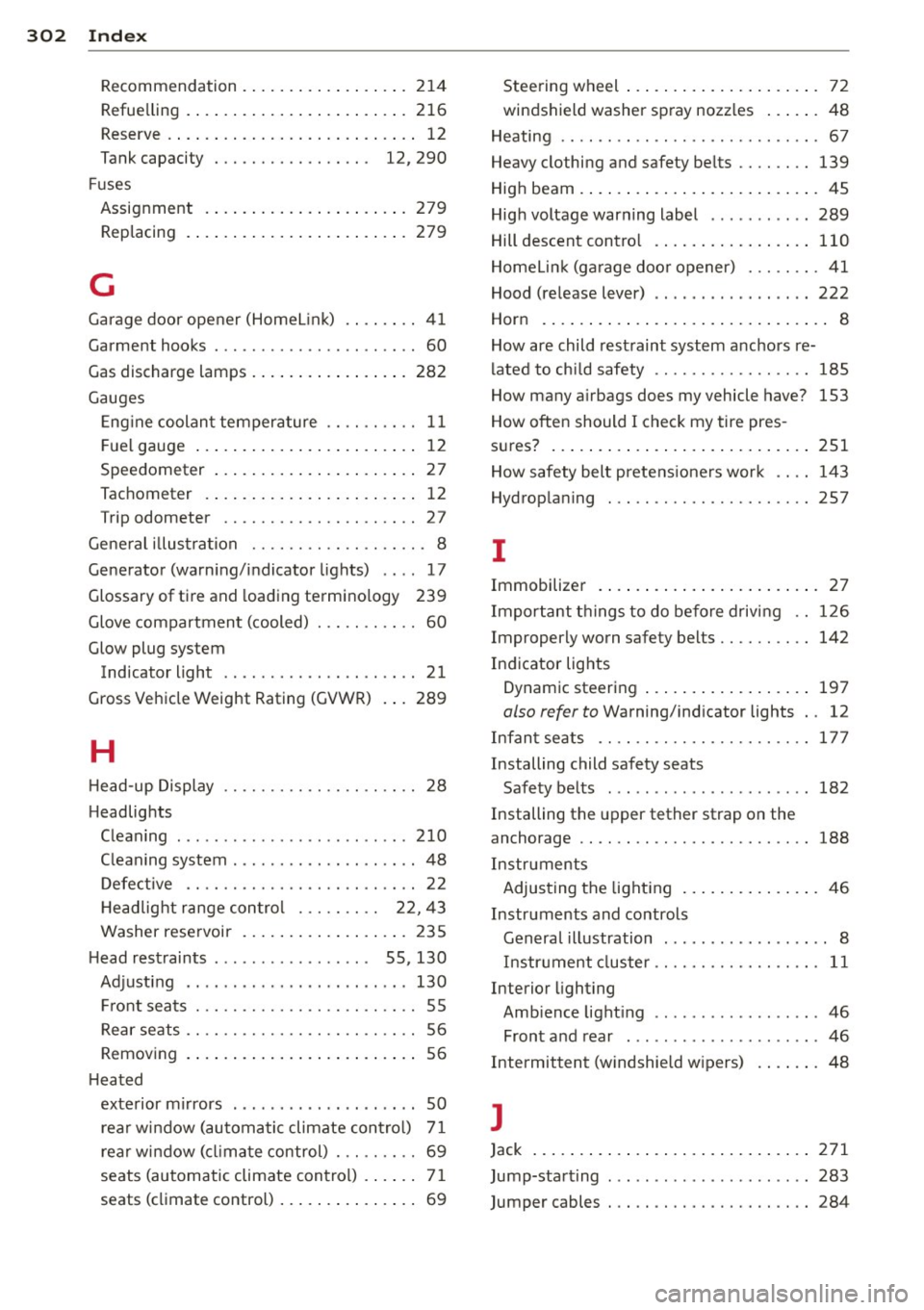
302 Index
Recommendation ................. . 214
Refuelling .. ... .......... .. .. .... . 216
Reserve .. .. ... .......... .. .. .... .. 12
Tank capacity . . . . . . . . . . . . . . . . . 12, 290
Fus es
Assignment ... ........ .. .. .. .... . 279
Replacing ... .. .......... .. .. .... . 279
G
Garage door opener (Homel ink) .. .... . . 41
Garme nt hooks . . . . . . . . . . . . . . . . . . . . . . 60
Gas discharge lamps ................. 282
Gauges Engin e coolant temperature .. .. .. .... 11
Fu el gauge .. .. .......... .. .. .... .. 12
Speedometer .. .......... .. .. .... .. 27
Tachometer ... .......... .. .. .... .. 12
Trip odometer ............... .... .. 27
General illus trat ion ........ .. .. .. .. . ..
8
Generator (warn ing/indicator lights) .. .. 17
Glossary of tir e and loading termino logy 239
Glove compartment (cooled) . . . . . . . . . . . 60
Glow plug system Indicator light . . . . . . . . . . . . . . . . . . . . . 21
Gross Vehicle Weight Rating (GVWR) ... 289
H
Head-up Display . . . . . . . . . . . . . . . . . . . . . 28
He adlights
C leani ng ... ... .. .. ...... .. .. .. .. . 210
Cleaning system ... ..... .. .... .. ... . 48
D efe ctiv e . . . . . . . . . . . . . . . . . . . . . . . . . 22
H ead light range control . . . . . . . . . 22, 43
Washer reservoir .................. 235
Hea d restraints . . . . . . . . . . . . . . . . . 55, 130
Ad justing .. ........ ..... .. ....... 130
Front seats . . . . . . . . . . . . . . . . . . . . . . . . 55
Rear seats . . . . . . . . . . . . . . . . . . . . . . . . . 56
Removing .. .. . .......... .. .. .... .. 56
Heate d
exterior mirrors . . . . . . . . . . . . . . . . . . . . SO
rear window (automatic climate control) 71
r ea r window (climate control) . .. .. .. . . 69
seats (au tomatic climate control) . . . . . . 71
seats (climate control) ..... .. .. .... .. 69 Steering
wheel . . . . . . . . . . . . . . . . . . . . . 72
windshield washer spray nozzles ... .. . 48
Heating .... .... .................... 67
Heavy clothing and safety be lts ........ 139
High beam . ..... .. .. ........... .. .. . 45
High voltage warning label .... ... .. .. 289
Hill descent control ... .......... .. .. 110
Homelink (garage door opener) ... .. .. . 41
Hood (release lever) .... .... ..... .. .. 222
Horn ............................... 8
How are child restraint system anchors re-
lat ed to child safety ................. 185
How many air bags does my vehicle have? 153
How often should I check my tire pres-
s ur es? ... .. .... .. ... .. .......... .. 251
How safety belt prete nsion ers work .. .. 143
Hydrop la ni ng ... .. ............. .. .. 257
I
Immobilizer . ..... .. ........... .. .. . 27
Important things to do before driving .. 126
Improperly worn safety belts ...... .... 142
Indicator lights
Dynamic steering .... .......... .. .. 197
also refer to Warning/indicator lights .. 12
Infant seats .. .. .. ............. .. .. 177
Installing child safety seats Safety belts . .. .. .......... ... .. .. 182
Installing the upper tether strap on the
anchorage .. ....................... 188
Instruments Adjusting the lighting ............ .. . 46
Instr uments and controls
General illustration . .. ... ... ... ...... 8
Instrument cluster . . . . . . . . . . . . . . . . . . 11
Interior lighting
Ambience lighting ... .. ..... ... .. .. . 46
Front and rear ... ... .. ..... ... .. .. . 46
Intermittent (w indshie ld w ipers) . ... .. . 48
J
Jack ..... .. .... .. .. ... ........ .. .. 271
Jump-starting . .. .. ..... ..... ... .. .. 283
Jumper cables ...................... 284